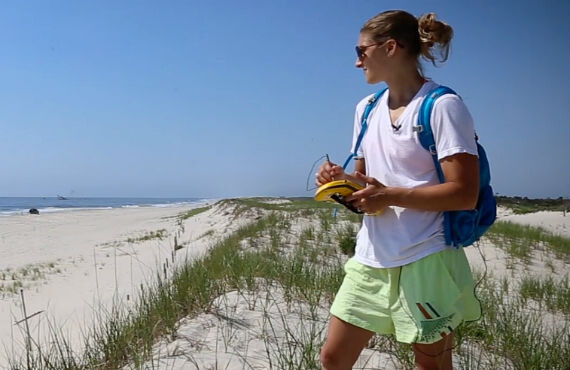Penn Doctoral Student Studies Coastal Dune Management and Erosion Prevention
by Patrick Ammerman
Coastal dunes can pile up large amounts of sand, like a sandcastle. But, while a sandcastle can be completely washed away when it rains or blown away by a strong wind, dunes are much more tenacious. That’s because natural dunes have plants as supports to hold stabilize them in place, reducing erosion from wind and rain.
A pair of new papers provide insight about coastal dune management and the plants that stabilize them. Bianca Reo Charbonneau, a biology doctoral candidate at the University of Pennsylvania, led research on both biological and non-biological methods to stabilize coastal dunes. The findings have implications for management of coastal environments.
[vimeo]175598576[/vimeo]
Dunes are a valuable part of beach ecosystems; they prevent erosion of sand from the beach at high tide and during storms, buffering upland areas. Dunes are able to withstand the eroding forces because they are held together by the root systems of specialized grasses that are adapted to live in sand. The roots of dune plants stabilize the dune, and the leaves offer a surface to catch sand blown about by the wind, building up the dune over time.
Hurricanes and large storms, like Hurricane Sandy in 2012, can destroy coastal dunes and uproot the grasses that live on them. Charbonneau researches coastal dune formation and is especially focused on management practices to rebuild dunes after large storms along the Mid-Atlantic shoreline.
“It can take up to seven years for the plants to really become fully established and build up a dune system,” she said, “which doesn’t really fit with people’s timeline. We want an instant recovery.”
Coastal managers, government agencies and communities often chose to facilitate recovery of dunes or re-buffer vulnerable areas after storms have eroded them. Charbonneau led two new studies that generally aimed to understand the best ways to quickly and efficiently rebuild dunes.
In the first paper, published in Shore and Beach, Charbonneau and co-author John P. Wenk of the Marine Academy of Technology and Environmental Science compared the effectiveness of two types of fencing configurations to rebuild dunes.
The researchers studied fencing installed on the shoreline of New Jersey after Sandy. Fencing is typically installed post-storm as an obstruction that catches wind blown sand so that it accumulates in a mound. Charbonneau measured weekly differences in accumulation between straight fencing, which runs parallel to the shore, versus a zig-zag configuration at 45-degree angles to the shoreline.
While both fencing options are currently used, the researchers’ findings support using zig-zag configuration at the onset of recovery. It accumulated sand more quickly after being installed.
The conclusion was not a surprise to Charbonneau, since fencing configurations with more angles and surface area would have a higher chance of catching sand particles.
“You don’t necessarily know which direction the sand is going to be coming from,” she said, “and so the more angles you have the higher likelihood you have of catching sand that could be blowing in any one direction.”
A major limitation of type of fencing as a management tool is that its height is fixed and does not change as sand accumulates around it. Once three-quarters of it is buried, new fences must be installed above the old or lifted to continue accumulating sand, but the process for raising them disturbs the sand that is built up in front of and behind the fence. A better long-term option is to enlist the help of nature, planting new grasses that encourage dune formation.
In the second study published in the Journal of Environmental Management, Charbonneau and colleagues Wnek, J. Adam Langley and Ronald Balsamo of Villanova and Gina Lee of Boston University looked at how much structure two plant species provided a dune. They compared a species native to the Mid-Atlantic region, American beachgrass, to an invasive species, Asiatic sand sedge. The researchers found a surprisingly stark difference between the two species.
“It’s particular to how much energy they allocate to their roots versus their shoots,” said Charbonneau.
The invasive species invested much more heavily in roots than the native species. When comparing the species, the scientists found that the invasive had seven times more root biomass than the native and four times more total biomass, despite a lack of difference in leaf biomass.
Charbonneau speculates that this greater below-ground biomass, as seen in the invasive species, would translate to increased resistance to erosion during storms. As an invasive species, however, Asiatic sand sedge comes with negative consequences, such as compromising local biodiversity.
Charbonneau conducted her research on fencing configurations in the summer of 2013 supported by the Friends of Island Beach State Park in the Barnegat Bay Student Grant Program. The dune grass research was supported by Villanova University’s Biology Department as a part of Charbonneau’s master’s thesis.
In future research, Charbonneau hopes to study how differences in dune plant root systems affect the size and shape of the dunes themselves.
Video by Alex Schein.








